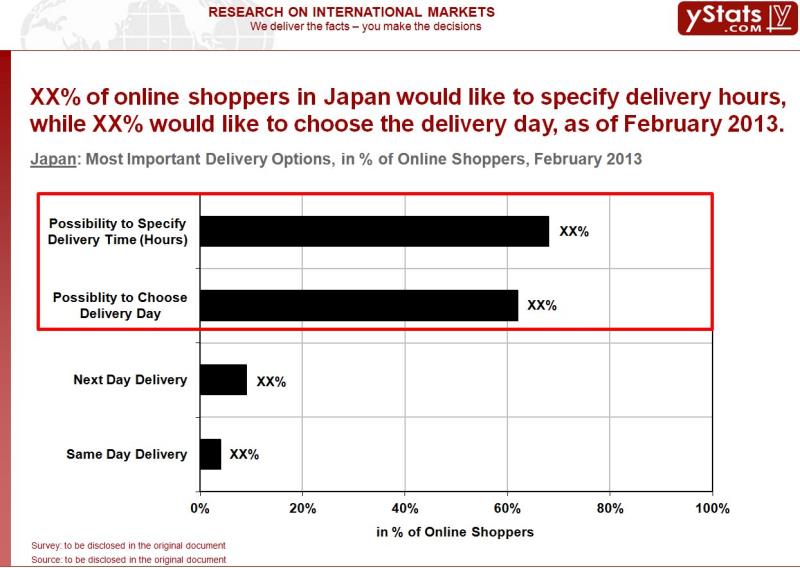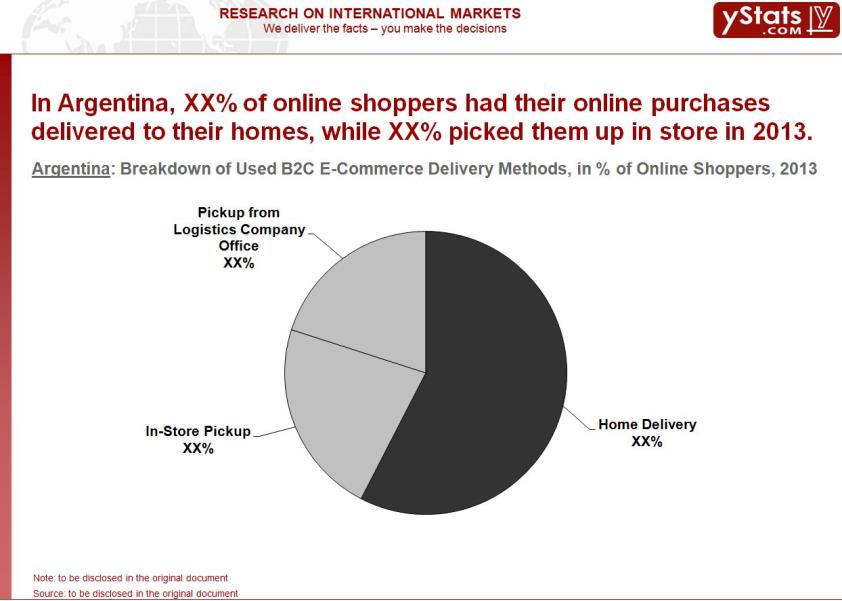The researchers at Hamburg-based secondary research organization yStats.com report in their new publication, “Global B2C E-Commerce Delivery 2014“, that demand by consumers for free and convenient delivery is driving online retailers and delivery service providers to look for a wider range of delivery methods. Among the trends on the market are intensified competition for quick delivery, growth of the free delivery option, and a movement of some retailers to establish their own logistics and delivery services.
Since Amazon.com introduced same day delivery in the USA 2009, many E-Commerce players and multi-channel retailers have followed, such as Google Shopping, Nordstrom, eBay and Wal-Mart in the USA, online luxury retailer Net-a-Porter in the UK, online merchants Snapdeal in India and Jingdong in China. However, global surveys show that many online shoppers value free delivery over same-day delivery. Shoppers also want other delivery options such as delivery at an appointed time, or pick-up in-store or at another arranged location. Another trend is that retailers are developing and strengthening their own delivery networks, moving fulfillment centers closer to customers and increasing delivery from nearby stores rather than logistics centers where possible. By intensifying these activities, online and multi-channel merchants are entering the province of fulfillment companies and parcel carriers such as DHL, UPS, FedEx, DPD and others.
In the North American E-Commerce market, more merchants in the USA offer free and same-day delivery options, while the larger ones are developing their own delivery fleets. The same-day delivery became a trend among cross-channel and online merchants, even though less than 10% of shoppers say that same delivery is a top factor in shopping. More than three quarters of online shoppers value free delivery more than same day delivery. Free or low cost shipping was the most important aspect of the online shopping experience for majority of online shoppers in Canada, also.
The B2C E-Commerce market in Latin America faces other issues. In Brazil, the major challenges are high consumer demand for free shipment and consumer frustration with delays in delivery. The postal system accounts for the largest share of the B2C E-Commerce delivery in Brazil. In Argentina, over half of online shoppers had their online purchases delivered to their homes in 2013, while a quarter picked them up in store. Online shoppers in Mexico value free shipping, as more than half are ready to add items to the cart in order to qualify for free shipping, and online retailers who have offered free shipping promotions note significant increase in sales.
Online shoppers in Europe also value free shipping. Free delivery for future purchases was expected almost two thirds of online shoppers in Germany, Switzerland and Austria. In those Central European nations the online retailers focused their efforts on timely delivery. Same day delivery is becoming the standard for online merchants in Germany, even though consumers would prefer free delivery within two or three days. High delivery cost was among the main reason for abandoning an online shopping cart in Germany.
In Western Europe, online shoppers in the UK are looking for wider delivery options, with free delivery as one of the key factors in making a purchase decision. In France, the national postal operator La Poste was the leading player on the B2C E-Commerce delivery market in 2013. A third of online shoppers in France chose an online retailer based on the speed of delivery. The share of online shoppers in the Netherlands indicating speed of delivery as important grew in 2013. In Spain, length of delivery time was the reason for close to 20% shoppers to abandon their online shopping cart.
The B2C E-Commerce delivery systems in Eastern Europe respond to a variety of challenges. The delivery market in Russia is growing rapidly, with most of the increase going to couriers rather the postal system. As for delivery times, half of Russian online shoppers were willing to wait for their online purchases to be delivered within one week, however, in reality, over a third of online shoppers had to wait for one to several weeks for delivery, and over 10% for several months. In Poland, the majority of online shoppers waited just a couple of days for delivery of online purchases, and majority of Polish shoppers perceived delivery costs to be too high. The presence of a home delivery option was a popular reason for shoppers in Turkey to buy online and not in store in 2012. Moreover, the majority of online shoppers in Turkey chose a particular store because of rapid and reliable home delivery. On the other hand, In Ukraine, the vast majority of online shoppers prefer to pick up their online purchases themselves from the courier’s office, the post office or from the store.
In the Scandinavian nations, home delivery was the most preferred option and online shoppers were willing to accept a delivery time of several days to lower the cost of the purchase.
Online shoppers in Asia generally seem to give more importance to speed of delivery. Fast delivery was an important criteria for choosing an online shop for nearly 20% of online shoppers in Japan in 2012. A third of online shoppers waited for 3 days for their online purchase to arrive, while a slightly larger share waited for around week at one point last year. Moreover, the majority of online shoppers in Japan would like to have the option to specify delivery hours and to choose the delivery day. In South Korea, B2C E-Commerce delivery is one of the major fields for intense competition in online retail. The majority of B2C E-Commerce orders were delivered door-to-door last year, nearly all by couriers as postal services accounted for less than 1%.

Competition on the fast growing B2C E-Commerce delivery market in China is fierce, involving local and international operators and retailers, who fight for offering more options and faster delivery times. In September 2013, a high double-digit share of online shoppers in China regarded free shipping as the major factor in B2C E-Commerce delivery.
In other Asian nations, several large online merchants launched same day delivery in India early this year despite the undeveloped logistics infrastructure. In Indonesia, less than 20% of online shoppers in have ever received free delivery of goods purchased online, while in Singapore this share was higher than one third.
In the Middle East, major B2C E-Commerce companies warn of possible delays in delivery and offer delivery times as long as up to 30 days. “Free Delivery” and “Same Day Delivery” were the two most important delivery options for online shoppers in the Middle East in 2013.
In Africa, B2C E-Commerce delivery was hindered by poor logistics, but driven by demand of consumers for speedy and cost-efficient delivery. In Egypt, delay in expected delivery was a problem faced by over 10% of online shoppers. Similarly, in Morocco concern about delivery was the main reason for a quarter of consumers not to shop online at one point last year. This same concern prevailed in South Africa, as “Delivery Times” was the main obstacle to buying products online, according to over a third of consumers in South Africa in June 2013. Both “Free Delivery” and “Same Day Delivery” were the two delivery options most wanted by online shoppers in South Africa last year.
The increasing comfort of shoppers around the world to make purchases online, with the attendant need for delivery of those purchases has resulted in competition amongst courier delivery services and between those services and national postal operators. The competition will likely result in improved and lower cost service to the consumer as time goes on.



